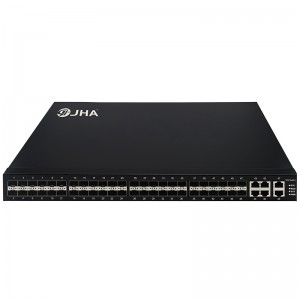The network monitoring system occupies an absolute position in the security project. In the high-definition network video monitoring system, there are often phenomena such as picture delays and freezes. There are many reasons for these phenomenons, but in most cases, the switch configuration is not reasonable enough, resulting in insufficient bandwidth. The switch is an indispensable device for the entire system. Whether it is configured correctly or not directly affects the later stability of the network monitoring system.
When choosing a switch, you should choose from the bandwidth and packet forwarding rate. The backplane bandwidth is the maximum amount of data that can be handled between the switch interface processor or interface card and the data bus. It marks the total data exchange capacity of the switch, the higher the backplane bandwidth, the stronger the ability to process data. Packet forwarding rate is also called port throughput, which refers to the ability of a router to forward data packets on a port. The higher the packet forwarding rate, the better.
In terms of network topology, a medium and large high-definition network video surveillance system needs to adopt a three-layer network architecture: access layer, convergence layer, and core layer.
How to choose access layer switch?
The access layer switch is mainly connected to the front-end network high-definition camera and connected to the aggregation switch. Based on the 4M code stream of 1080P network cameras, how many channels of 1080P network cameras can be connected to a single 100M port access switch?
The actual bandwidth of our commonly used switches is 50%-70% of the theoretical value, so the actual bandwidth of a 100M port is 50M-70M. 4M*12=48M, so it is recommended that one 100M access switch can connect to a maximum of 12 1080P network cameras. At the same time, considering that the current network monitoring adopts dynamic encoding, the peak value of the camera code stream may exceed 4M bandwidth, and the bandwidth redundancy design is also considered. Therefore, it is best when a 100M access switch is controlled within 8 units, and more than 8 units are recommended. Gigabit port. In some ultra-high-definition network monitoring systems, in order to ensure high-definition video images and high reliability of data transmission, the access layer can also directly select full Gigabit switches.
How to choose aggregation layer switch?
The aggregation layer switch is mainly connected to the access layer switch and the core switch of the uplink monitoring center. The performance is higher than that of the access switch. Under normal circumstances, the aggregation switch needs to choose a Layer 2 switch with a gigabit upload port. The 100M port of the switch is connected to the switch, and the Gigabit port is connected to the core switch of the monitoring center. The number of interfaces on the aggregation switch should be controlled within 30. It is still calculated based on the 4M code stream of 1080P network cameras. Each access layer switch at the front end has 6 1080P network cameras, and the aggregation switch is connected to 5 access layer switches. The total bandwidth of the aggregation switch is 4M*6*5=120M, so the cascade port of the aggregation switch and the core switch should be a gigabit port.
How to choose core switch?
The core layer switch is mainly connected with the aggregation layer switch, the uplink monitoring center video monitoring platform, storage server, digital matrix and other equipment, which are the core of the entire high-definition network monitoring system.then choosing a core switch, you must consider the bandwidth capacity of the entire system and how to configure the core layer switch improperly, which will inevitably cause the video screen to fail to display smoothly.therefore, the monitoring center recommends choosing a full gigabit core switch. If there are many points, VLANs need to be divided, and a three-layer full Gigabit core switch should be selected. A large-scale surveillance system with more than 150 cameras should consider a three-layer 10 Gigabit core switch.
Key points of switch selection
When selecting a switch for video surveillance in a local area network, because the main pressure is on the aggregation layer switch, the aggregation layer switch has to bear the pressure of monitoring and storing traffic as well as the pressure of real-time view and call monitoring. Therefore, it is particularly important to choose the applicable aggregation switch. It is recommended to choose a gigabit managed switch, which can configure the network, optimize and increase the bandwidth utilization rate, and ensure the smoothness of transmission.
Precautions
If you choose Web-managed switch management, it will be more convenient. It is best to choose a speed-limiting switch, and when choosing a switch with a large cache, at the same time, the network monitoring system requires high stability and real-time performance, and the equipment working environment is complex and harsh, so for protection For stable and efficient transmission of system data, it is recommended to choose industrial Ethernet switch products with high industrial performance and good stability.
Post time: Jan-08-2021






